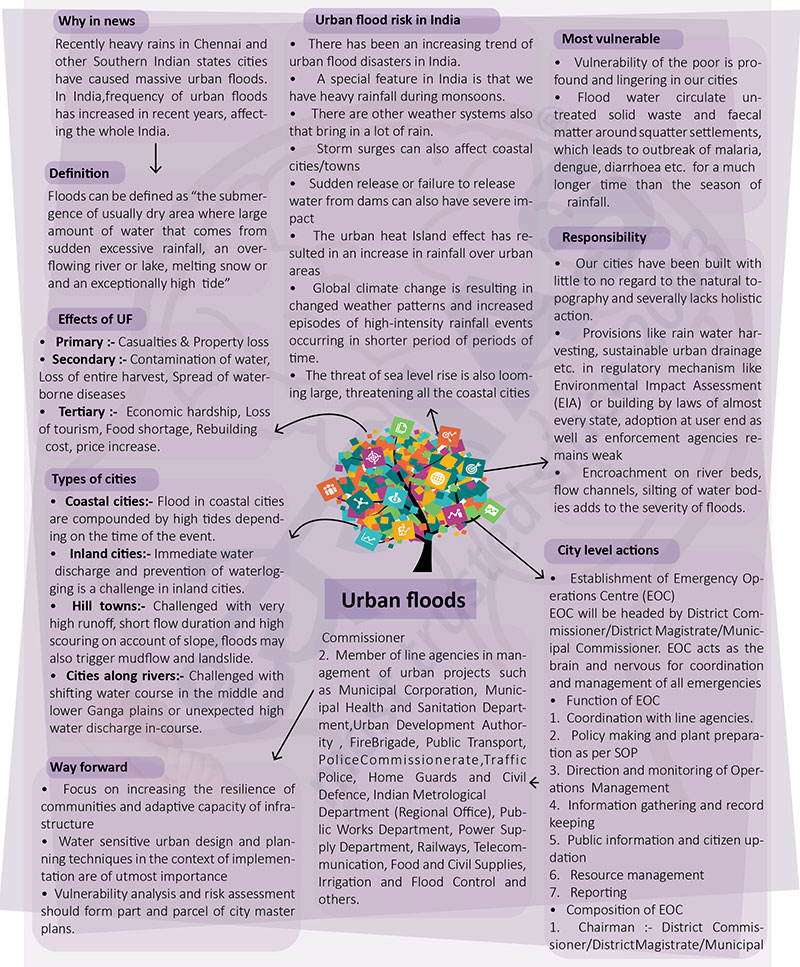Why in news?
- Recently heavy rains in Chennai and other Southern Indian states cities have caused massive urban floods. In India, frequency of urban floods has increased in recent years, affecting the whole India.
Definition
Floods can be defined as “the submergence of usually dry area where large amount of water that comes from sudden excessive rainfall, an overflowing river or lake, melting snow or and an exceptionally high tide”
Effects of UF
- Primary :- Casualties & Property loss
- Secondary :- Contamination of water, Loss of entire harvest, Spread of waterborne diseases
- Tertiary :- Economic hardship, Loss of tourism, Food shortage, Rebuilding cost, price increase.
Types of cities
- Coastal cities:- Flood in coastal cities are compounded by high tides depending on the time of the event.
- Inland cities:- Immediate water discharge and prevention of waterlogging is a challenge in inland cities.
- Hill towns:- Challenged with very high runoff, short flow duration and high scouring on account of slope, floods may also trigger mudflow and landslide.
- Cities along rivers:- Challenged with shifting water course in the middle and lower Ganga plains or unexpected high water discharge in-course.
Urban flood risk in India
- There has been an increasing trend of urban flood disasters in India.
- A special feature in India is that we have heavy rainfall during monsoons.
- There are other weather systems also that bring in a lot of rain.
- Storm surges can also affect coastal cities/towns
- Sudden release or failure to release water from dams can also have severe impact
- The urban heat Island effect has resulted in an increase in rainfall over urban areas
- Global climate change is resulting in changed weather patterns and increased episodes of high-intensity rainfall events occurring in shorter period of periods of time.
- The threat of sea level rise is also looming large, threatening all the coastal cities
Most vulnerable
- Vulnerability of the poor is profound and lingering in our cities
- Flood water circulate untreated solid waste and faecal matter around squatter settlements, which leads to outbreak of malaria, dengue, diarrhoea etc. for a much longer time than the season of rainfall.
Responsibility
- Our cities have been built with little to no regard to the natural topography and severally lacks holistic action.
- Provisions like rain water harvesting, sustainable urban drainage etc. in regulatory mechanism like Environmental Impact Assessment (EIA) or building by laws of almost every state, adoption at user end as well as enforcement agencies remains weak
- Encroachment on river beds, flow channels, silting of water bodies adds to the severity of floods.
City level actions
- Establishment of Emergency Operations Centre (EOC) EOC will be headed by District Commissioner/ District Magistrate/Municipal Commissioner. EOC acts as the brain and nervous for coordination and management of all emergencies
- Function of EOC
- Coordination with line agencies.
- Policy making and plant preparation as per SOP
- Direction and monitoring of Operations Management
- Information gathering and record keeping
- Public information and citizen updation
- Resource management
- Reporting
- Composition of EOC
- Chairman :- District Commissioner/ DistrictMagistrate/Municipal Commissioner
- Member of line agencies in management of urban projects such as Municipal Corporation, Municipal Health and Sanitation Department, Urban Development Authority , FireBrigade, Public Transport, Police Commissionerate, Traffic Police, Home Guards and Civil Defence, Indian Metrological Department (Regional Office), Public Works Department, Power Supply Department, Railways, Telecommunication, Food and Civil Supplies, Irrigation and Flood Control and others.
Way forward
- Focus on increasing the resilience of communities and adaptive capacity of infrastructure
- Water sensitive urban design and planning techniques in the context of implementation are of utmost importance
- Vulnerability analysis and risk assessment should form part and parcel of city master plans.







